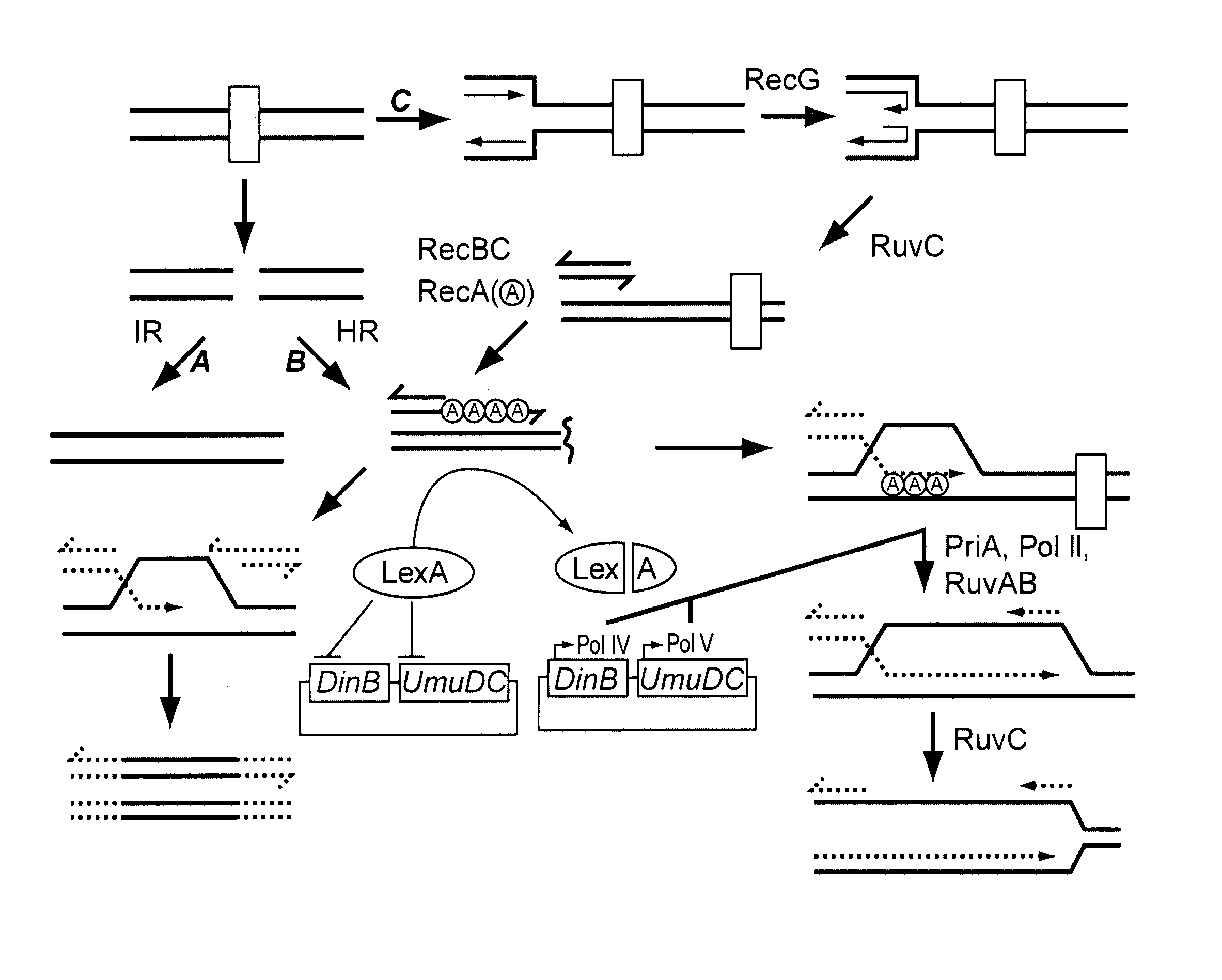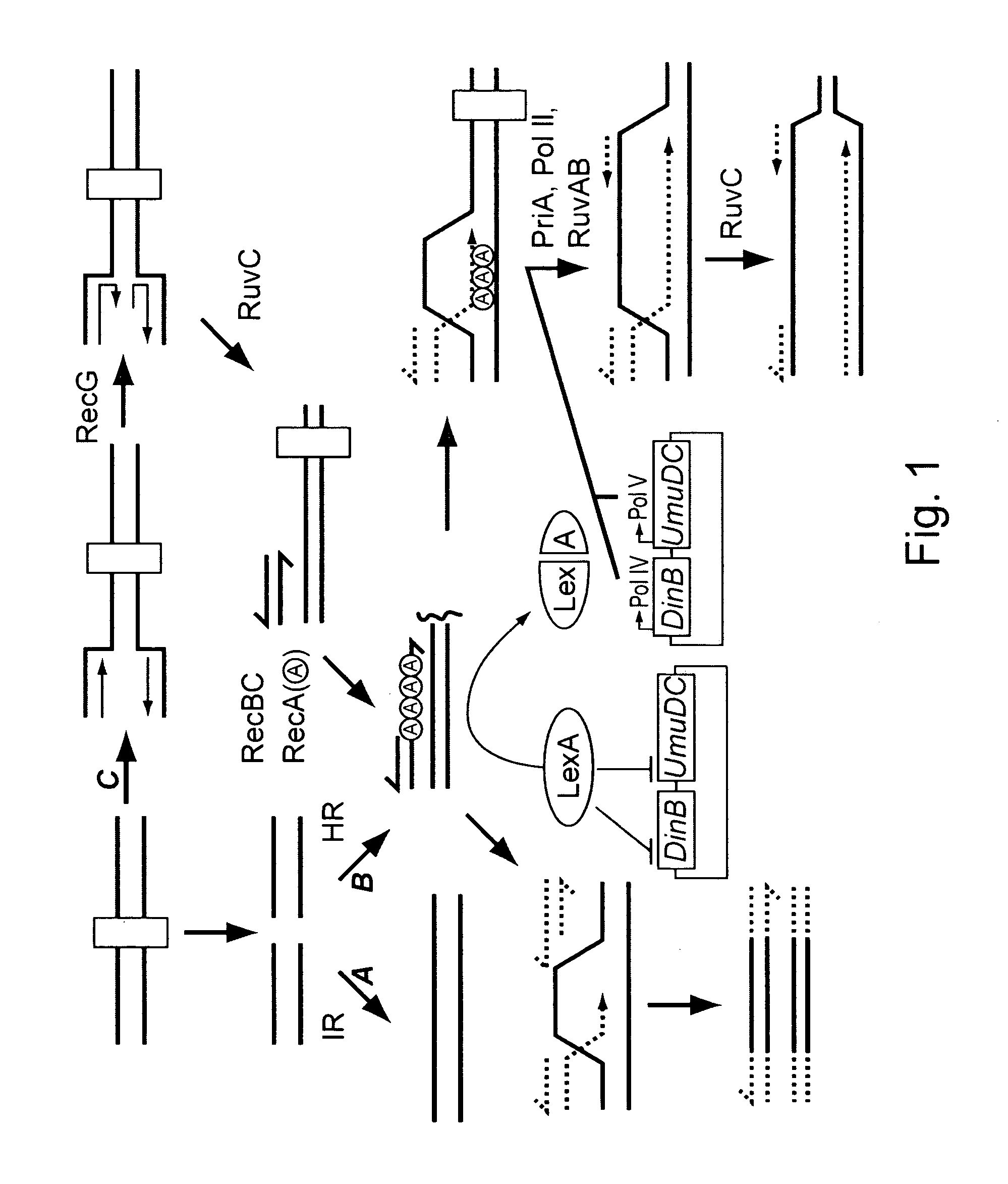Business methods for commercializing antimicrobial and cytotoxic compounds
a technology of cytotoxic compounds and business methods, applied in the field of business methods for commercializing cytotoxic compounds, can solve problems such as drug resistance, cancers that cannot be treated by chemotherapy, and development is particularly troubling
- Summary
- Abstract
- Description
- Claims
- Application Information
AI Technical Summary
Benefits of technology
Problems solved by technology
Method used
Image
Examples
example 1
RecA, RecB, RecG, priA, RuvB and ruvC Mutants Exhibit an Increased Sensitivity to Sublethal Doses of Ciprofloxacin
[0190] The contribution of different components of DNA recombination and repair pathways in mediating ciprofloxacin resistance was determined by examining the effect of various mutations. The experiments were performed using the E. coli strain MG1655 as the genetic background, since this K-12 strain was used in the E. coli genome sequencing project. Strains listed in Table 1 were constructed using PCR-mediated gene replacement. See Murphy, K C, et al., Gene 2000, 246:321-330. PCR reactions were performed using Platinum pfx DNA polymerase from Invitrogen, with standard cycling parameters. Genomic template DNA was prepared from a fresh bacterial overnight culture using the DNeasy kit (Qiagen).
[0191] The kanamycin cassette was PCR amplified from a pUC4K plasmid using primers 5′-GGA AAG CCA CGT TGT GTC TC and 5′-CGA TTT ATT CAA CAA AGC CGC. Gene specific components from ea...
example 2
The Roles of Various Genes in Determining Sensitivity to Ciprofloxacin and the Ability to Evolve Resistance to Ciprofloxacin
[0202] With the isogenic loss of function strains in hand, mutation in response to ciprofloxacin (obtained from U.S. Biologicals) was determined using a protocol based on the Stressful Lifestyle Adaptive Mutation (SLAM) assay, as depicted in FIG. 3. Five colonies of each strain, selected from 30 ug / mL kan plates, were grown for 24 hours in LB at 37° C. Dilutions of each culture were made in duplicate and plated on LB plates to determine the number of viable cells.
[0203] To assay for mutation, 150 μL of each culture was plated twice on LB plates containing 35 ng / mL ciprofloxacin. Also, two 150 μL cultures from each strain were plated on five additional plates for use in ‘survival’ experiments (see below). The concentration of ciprofloxacin used was chosen based on trial experiments with the MG1655 parent strain which indicated that 35 ng / mL ciprofloxacin maxim...
example 3
Deletion of recB Sensitizes Both FQS and FQR Strains to Ciprofloxacin
[0208] To investigate the effect of recB mutation in FQr gyrA mutants, the recB gene was deleted from gyrA FQr mutants, and these strains were assayed for ciprofloxacin response (Table 4). The deletion of recB was carried out using P1-mediated transduction of a recB::Kmr allele into strains harboring gyrA FQr mutations, including gyrA-S83L in two different strain backgrounds, and gyrA-D87G.
[0209] Notably, it was demonstrated that deletion of recB from each of the gyrA FQr mutant strains significantly re-sensitized the strains to ciprofloxacin, 5- to 8-fold depending upon the strain background and the specific gyrA* mutation. In addition, deletion of recB from a wild-type FQ-sensitive strain sensitized the strain approximately 8-fold. Taken together, these results demonstrate that an inhibitor of RecB is an effective combination therapy with fluoroquinolone antibiotics against both FQ-sensitive as well as FQ-resis...
PUM
 Login to View More
Login to View More Abstract
Description
Claims
Application Information
 Login to View More
Login to View More - R&D
- Intellectual Property
- Life Sciences
- Materials
- Tech Scout
- Unparalleled Data Quality
- Higher Quality Content
- 60% Fewer Hallucinations
Browse by: Latest US Patents, China's latest patents, Technical Efficacy Thesaurus, Application Domain, Technology Topic, Popular Technical Reports.
© 2025 PatSnap. All rights reserved.Legal|Privacy policy|Modern Slavery Act Transparency Statement|Sitemap|About US| Contact US: help@patsnap.com



